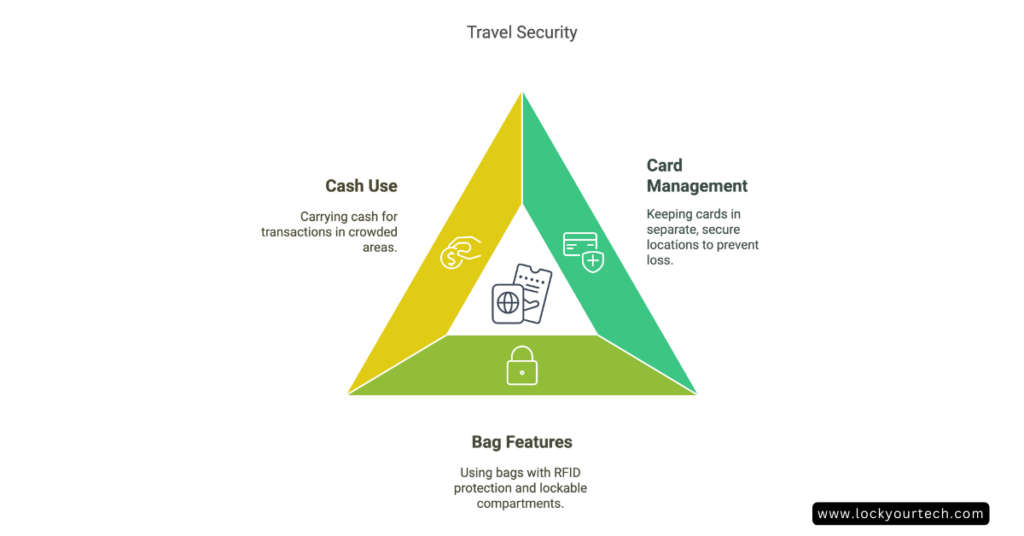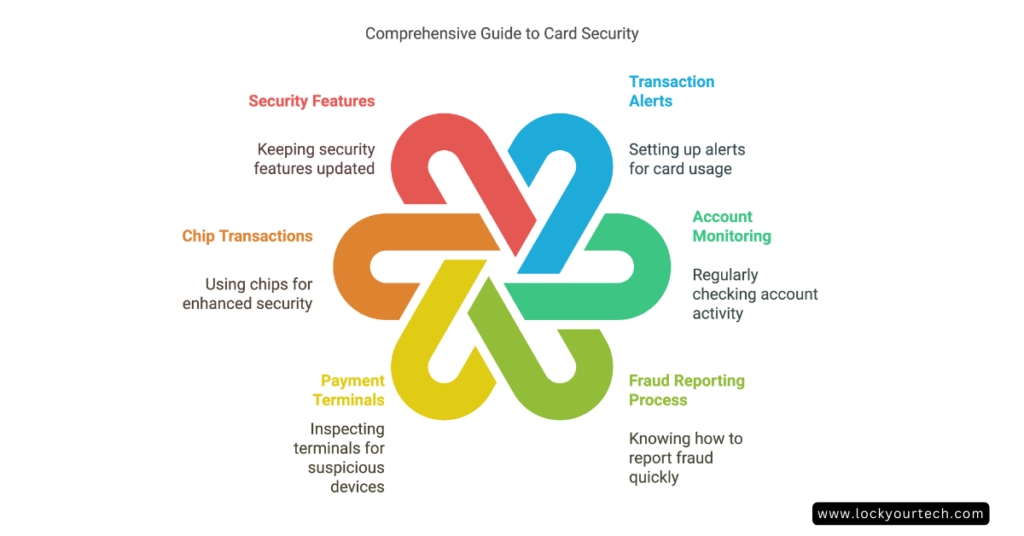Picture this: You’re walking through a crowded mall, and someone brushes past you. Nothing unusual, right? Well, what if I told you that brief moment could be all it takes for a tech-savvy thief to scan your credit card information? As someone who’s spent years helping people secure their finances, I’ve seen how credit card scanning has evolved from a rare threat to a daily concern. Nowadays, learning how to protect your credit cards from being scanned isn’t just smart—it’s essential.
With about 151 million Americans having faced credit card fraud, it’s time we talk about keeping your cards safe.
Key Takeaways
- Invest in RFID blocking protection (wallet, sleeve, or card case) to prevent skimmers from stealing your credit card information through contactless scanning.
- Monitor your credit card statements regularly and enable real-time alerts from your bank or credit card company to catch unauthorized transactions early.
- When making online purchases, only use secure websites (https://) and avoid storing your credit card details on shopping sites to protect against hackers.
- Consider using virtual cards or mobile payment solutions for enhanced security when swiping your card or making online transactions.
- Keep your physical cards safe by separating credit and debit cards in your wallet or purse, and use chip readers instead of magnetic strips when possible.
Understanding Credit Card Scanning
Let me break this down in a way that won’t make your head spin. You know those fancy tap-to-pay cards in your wallet? They use something called RFID technology – basically, a tiny radio transmitter inside your card that makes contactless payments possible. Pretty cool, right? Well, here’s where things get tricky.
Imagine this: I was recently at a coffee shop when I noticed someone holding what looked like a phone, but slightly bulkier, near people’s bags. That’s a card scanner in action, folks. These devices can grab your card info from several inches away, and you’d never know it happened. It’s like having someone peek into your wallet without touching it.
The scariest part? These scanners are getting cheaper and more accessible. They were once tools used only by sophisticated criminals, but now anyone with basic tech knowledge can order one online. Trust me, I’ve seen college students demonstrate these devices at cybersecurity fairs – it’s eye-opening how easy it is to capture card information.
But don’t panic! Knowledge is power, and understanding how these scanners work is your first step toward protecting yourself. Think of it like knowing how a burglar might try to break into your house – once you know their tactics, you can better defend against them.

Physical Protection Methods
I’ve got to tell you about something that happened to my colleague last month. She was traveling through Europe when her card got scanned at a busy train station. The thief racked up $500 in charges before she even noticed. That’s why I’m now a huge advocate for physical protection methods – they’re your first line of defense.
Let’s talk RFID-blocking solutions first. These are like little force fields for your cards:
- RFID-blocking wallets: Made with special materials that block scanning signals. I personally use one that looks like a regular leather wallet but has a protective mesh built in.
- Card sleeves: Think of them as tiny shields for individual cards. They’re perfect if you don’t want to replace your favorite wallet.
- The VAULTCARD approach: This neat device actively jams scanning signals. Pop it in your wallet, and it creates an electronic barrier around your other cards.
But here’s a pro tip I learned from a security expert: strategic card storage is just as important. Here’s what I recommend:
- Never keep all your cards in one place when traveling. I keep my backup card in a separate, secure location.
- Look for bags with built-in RFID protection and lockable compartments. They’re worth the investment.
- Sometimes, good old cash is your best friend, especially in crowded areas where scanners are more likely to be used.
| Related: How Long to Keep Financial Records: An Essential Guide
Digital Protection Strategies
You know what’s worse than discovering unauthorized charges? Not discovering them until it’s too late. I learned this the hard way when my sister’s card was compromised, and she didn’t notice for weeks. That’s why I’m obsessed with digital protection strategies – they’re your early warning system.
First, let’s talk about transaction monitoring. This is like having a personal security guard for your money:
- Set up those transaction alerts on your phone. I get a ping every time my card is used for more than $50.
- Make account monitoring a weekly habit. I do mine every Sunday evening while catching up on my favorite show.
- Know your card issuer’s fraud reporting process. When seconds count, you don’t want to be fumbling for phone numbers.
Now, about safe payment practices. These are the habits that’ll keep your card info secure:
- Always check payment terminals for anything suspicious. If something looks off, trust your gut and pay inside.
- Use chip transactions whenever possible. They’re like having a tiny encryption device working for you.
- Keep your cards’ security features up to date. When your issuer offers new security options, take advantage of them.

Online Safety Measures
Let me share something that still makes me cringe. Last year, I nearly fell for a fake banking website while shopping online. The URL looked legitimate at first glance, but something felt off. That’s when I noticed it was “http” instead of “https” – a rookie mistake that could have cost me big time. These days, I’m religious about online safety, and you should be too.
When it comes to secure shopping, here’s what keeps me sleeping soundly at night:
- Look for that little padlock icon and “https” in your browser. It’s like having a security guard checking IDs at the door.
- Public Wi-Fi networks? They’re about as secure as shouting your card number in a crowded room. I always use my mobile data for banking and shopping.
- Keep your security software fresh. Those updates might be annoying, but they’re like booster shots for your digital immune system.
Account security is another beast entirely. I treat my online banking credentials like the crown jewels:
- Never, ever share card details over email. No legitimate company will ask for that.
- Got a “Remember this card for next time” popup? That’s a hard no from me, especially on shared devices.
- After banking, log out properly. Don’t just close the tab – that’s like leaving your front door unlocked.
| Related: How to Report Scam Websites: A Universal Guide
Additional Security Measures
The world of card security keeps evolving, and I’m here for it. Just last week, I switched to using virtual cards for my online shopping, and honestly? Game changer. Modern protection methods are making old-school card scanning look like child’s play.
Here’s what’s working for me and my tech-savvy friends:
- Mobile payment solutions like Apple Pay and Google Wallet encrypt your data better than Fort Knox. They generate unique codes for each transaction, making stolen card numbers useless to thieves.
- Virtual cards let you create disposable card numbers for online shopping. It’s like wearing a disguise while shopping – even if someone gets the number, your real card stays safe.
- Most banks now use AI-powered fraud detection. I once got a call about a suspicious purchase before I even noticed it myself.
Pro tip: Take advantage of your bank’s security features. Many folks don’t know this, but most banks offer:
- Real-time purchase notifications
- Customizable spending limits
- Temporary card freezes when you’re not using them
- Location-based controls that prevent transactions outside your usual area
| Related: Top Ways to Protect Your Personal Information and Privacy
The Bottom Line
Protecting your credit cards from scanning isn’t just about buying the right wallet or downloading an app – it’s about developing a security mindset. Think of it as a layered approach: physical protection, digital vigilance, and smart banking habits working together.
Remember, criminals are constantly updating their tactics, but so are the good guys. Stay informed, stay cautious, but don’t let fear of card scanning keep you from enjoying the convenience of modern payment methods. With these protection strategies in place, you’re already steps ahead of potential threats.
Have questions about protecting your cards? Drop them in the comments below. I’d love to hear about your experiences and share more tips!
Frequently Asked Questions
What are the best RFID wallets available for credit card protection?
Top-rated RFID-blocking wallets include the Ridge Wallet, Travando, and Bellroy Hide & Seek. Look for wallets with military-grade RFID signal blocking technology that can protect multiple credit cards and passports simultaneously. Ensure the wallet has been tested to block 13.56 MHz frequencies, which is what most rfid credit card chips use.
How does e-skimming work and what can I do to prevent it?
E-skimming occurs when hackers inject malicious code into payment card processing systems to steal credit card information during online transactions. To protect yourself, use virtual cards for online payments, regularly monitor your credit card accounts, and only shop on reputable websites with secure payment processing systems.
Are there any specific brands of card sleeves that are highly recommended?
Popular and reliable card protection sleeves include Signal Vault Pro, DefenderShield, and Identity Guard RFID sleeves. The best way to protect your cards is to choose sleeves that block rfid signals across multiple frequencies and are independently tested. Look for sleeves that can protect both your credit card chip and the entire card from scanners.
How can I identify if a payment terminal has been tampered with?
Check for loose or damaged card readers, mismatched colors or materials, and any unusual protrusions around the card slot. When using your card, ensure the chip reader isn’t abnormally tight when inserting your credit card. Compare the terminal to others nearby – card skimmers often look slightly different from legitimate readers.
What are the signs of a skimming device at a gas pump?
Look for broken security seals on the pump panel, loose or wobbly card readers, and any unusual card slot overlays. Check that the credit card chip reader matches the pump’s overall appearance. If something seems off, pay inside or use a different pump to protect your credit cards from potential card theft.



